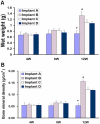Effects of initial cell density and hydrodynamic culture on osteogenic activity of tissue-engineered bone grafts
- PMID: 23326488
- PMCID: PMC3543387
- DOI: 10.1371/journal.pone.0053697
Effects of initial cell density and hydrodynamic culture on osteogenic activity of tissue-engineered bone grafts
Abstract
This study aimed to study the effects of initial cell density and in vitro culture method on the construction of tissue-engineered bone grafts and osteogenic activities. Human mesenchymal stem cells (hMSCs) were seeded onto cubic scaffolds prepared from demineralized bone matrix (DBM) by three methods - static, hydrodynamic, or fibrin hydrogel-assisted seeding. The resulting cell-scaffold constructs were cultured in vitro by static flask culture or hydrodynamic culture. The initial cell density and the subsequent in vitro proliferation and alkaline phosphate activities of the constructs were analyzed. The constructs were also subcutaneously implanted in nude mice to examine their in vivo osteogenic activities. Hydrogel-assisted seeding gave the highest seeding efficiency, followed by hydrodynamic and conventional static seeding. During in vitro culture, hydrodynamic culture produced higher plateau cell densities, alkaline phosphatase (ALP) activities, and extracellular matrix production than static culture. After subcutaneous implantation in nude mice, the implants prepared by the combination of hydrogel-assisted seeding and hydrodynamic culture produced higher wet weight and bone mineral density than implants prepared by other methods. The results suggest that the hydrogel-assisted seeding can substantially increase the initial seed cell density in scaffolds. Subsequent hydrodynamic culture can promote the proliferation and osteoblastic differentiation of the seeded cells. Correspondingly, bone grafts produced by the combination of these two methods achieved the highest osteogenic activity among the three methods employed.
Conflict of interest statement
Figures








Similar articles
-
Bioreactor culture duration of engineered constructs influences bone formation by mesenchymal stem cells.Biomaterials. 2017 Nov;146:29-39. doi: 10.1016/j.biomaterials.2017.08.044. Epub 2017 Sep 6. Biomaterials. 2017. PMID: 28898756 Free PMC article.
-
Towards an intraoperative engineering of osteogenic and vasculogenic grafts from the stromal vascular fraction of human adipose tissue.Eur Cell Mater. 2010 Mar 3;19:127-35. doi: 10.22203/ecm.v019a13. Eur Cell Mater. 2010. PMID: 20198567
-
Ectopic bone regeneration by human bone marrow mononucleated cells, undifferentiated and osteogenically differentiated bone marrow mesenchymal stem cells in beta-tricalcium phosphate scaffolds.Tissue Eng Part C Methods. 2012 Jul;18(7):545-56. doi: 10.1089/ten.TEC.2011.0470. Epub 2012 Feb 22. Tissue Eng Part C Methods. 2012. PMID: 22250840
-
Tissue engineering of the synovial joint: the role of cell density.Proc Inst Mech Eng H. 2007 Jul;221(5):429-40. doi: 10.1243/09544119JEIM288. Proc Inst Mech Eng H. 2007. PMID: 17822145 Review.
-
Tissue engineered bone grafts: biological requirements, tissue culture and clinical relevance.Curr Stem Cell Res Ther. 2008 Dec;3(4):254-64. doi: 10.2174/157488808786733962. Curr Stem Cell Res Ther. 2008. PMID: 19075755 Free PMC article. Review.
Cited by
-
In vitro mesenchymal trilineage differentiation and extracellular matrix production by adipose and bone marrow derived adult equine multipotent stromal cells on a collagen scaffold.Stem Cell Rev Rep. 2013 Dec;9(6):858-72. doi: 10.1007/s12015-013-9456-1. Stem Cell Rev Rep. 2013. PMID: 23892935 Free PMC article.
-
A Bioactive Hydrogel and 3D Printed Polycaprolactone System for Bone Tissue Engineering.Gels. 2017 Sep;3(3):26. doi: 10.3390/gels3030026. Epub 2017 Jul 6. Gels. 2017. PMID: 29354645 Free PMC article.
-
Fibromodulin reprogrammed cells: A novel cell source for bone regeneration.Biomaterials. 2016 Mar;83:194-206. doi: 10.1016/j.biomaterials.2016.01.013. Epub 2016 Jan 7. Biomaterials. 2016. PMID: 26774565 Free PMC article.
-
Computer-aided multiple-head 3D printing system for printing of heterogeneous organ/tissue constructs.Sci Rep. 2016 Feb 22;6:21685. doi: 10.1038/srep21685. Sci Rep. 2016. PMID: 26899876 Free PMC article.
-
3D Bioprinting of Human Adipose-Derived Stem Cells and Their Tenogenic Differentiation in Clinical-Grade Medium.Int J Mol Sci. 2020 Nov 18;21(22):8694. doi: 10.3390/ijms21228694. Int J Mol Sci. 2020. PMID: 33218011 Free PMC article.
References
-
- Ouyang A, Yang ST (2007) Effects of mixing intensity on cell seeding and proliferation in three-dimensional fibrous matrices. Biotechnol Bioeng 96: 371–380. - PubMed
-
- Zhang ZY, Teoh SH, Chong WS, Foo TT, Chng YC, et al. (2009) A biaxial rotating bioreactor for the culture of fetal mesenchymal stem cells for bone tissue engineering. Biomaterials 30: 2694–2704. - PubMed
-
- Seebach C, Schultheiss J, Wilhelm K, Frank J, Henrich D (2010) Comparison of six bone-graft substitutes regarding to cell seeding efficiency, metabolism and growth behaviour of human mesenchymal stem cells (MSC) in vitro. Injury 41: 731–738. - PubMed
Publication types
MeSH terms
LinkOut - more resources
Full Text Sources
Other Literature Sources
Medical

